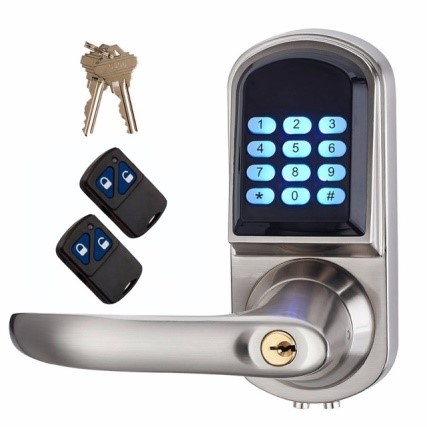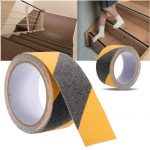Hey! Did you know June is National Safety Month? Safety and disability can go hand-in-hand, and assistive technology can help. From special locks, alarms and environmental adaptations, here are some examples on how people with disabilities can keep themselves and their families safe.
Locks
-
Wireless Remote Controlled Door Locks

For those with limited dexterity, fine motor skills, or cognitive impairments these types of lock for your home or office can be very helpful. Using either a remote control, your cell phone, or programming a series of numbers, you won’t have trouble with keys again. Also, with some locks, you can check and lock your front door from anywhere. Peace of mind guaranteed!
-
Medication Locks
Medication locks can not only keep you safe, but they can also help keep your family members safe. These types of devices can assist to secure medication, some can also can have reminder notifications to take medication. They also can be programed to only allow you to take your medications in certain doses and at certain times. For information on the Top 10 Best Automatic Pill Dispensers of 2018, review: http://top10buddy.com/top-10-best-automatic-pill-dispenser-review/
-
Accessible Combination Locks
These locks are great for people who are blind, low vision, or have cognitive disabilities. To check these out, go to Accessible Combination Locks.
Alarms
Alarms are crucial to the safety of individuals with disabilities. Whether it’s for a fire, carbon monoxide, or an intruder; having an accessible alarm is a necessity. An example of an accessible alarm is a smoke alarm with flashing lights or vibrators for individuals with hearing impairments. If you are interested in learning more and possibly borrowing an alarm to try, check out: Ability Tool’s AT Exchange.
Environmental Adaptions
-
Bathroom Safety
Bathrooms can be very dangerous for both people with disabilities and seniors. Simple products like grab bars, anti-slip mats, shower stools and more can make a huge difference. For more info on simple bathroom modifications check out: Top 5 ways to outfit the bathroom for disabled or elderly loved ones
-
Ramps
Ramps are essential for access, but can also be necessary for individuals with mobility impairments in evacuating safely from places with their necessary assistive technology. For more information on accessible ramps, check out the Ability Tools Blog: Building a Wheelchair Ramp: What you should know before tackling the project
Other safety ideas
-
Contrasting Tape

Use contrasting tape to label an exit or a change in level for those with low vision. Use brightly colored and highly contrasted tape to draw attention to edges of walls, cabinets, doors and exits for better navigation during an emergency.
-
Keep Exits Clear
Keeping exits clear from clutter and other things that may impair someone during an evacuation.
-
Exit Plan
Always have an exit plan. This is easier for your home, but what about malls, restaurants, and other public spaces? It’s important to know what you would need to do to get out of an area safely no matter who you are.
For more home safety tips, check out this article distributed by the Amputee Coalition of America and shared by the California Department of Social Services: Home Safety for People With Disabilities




